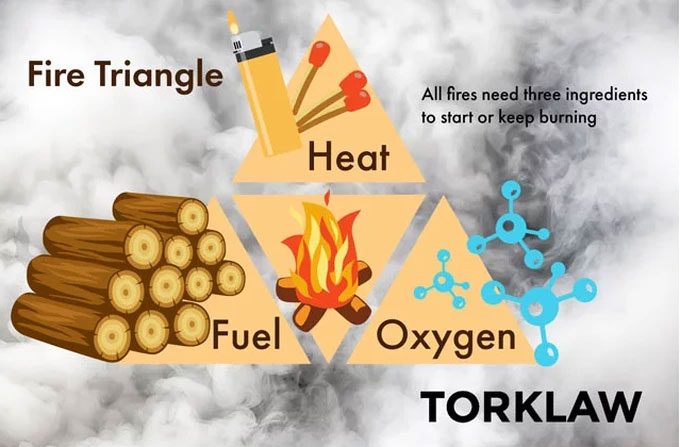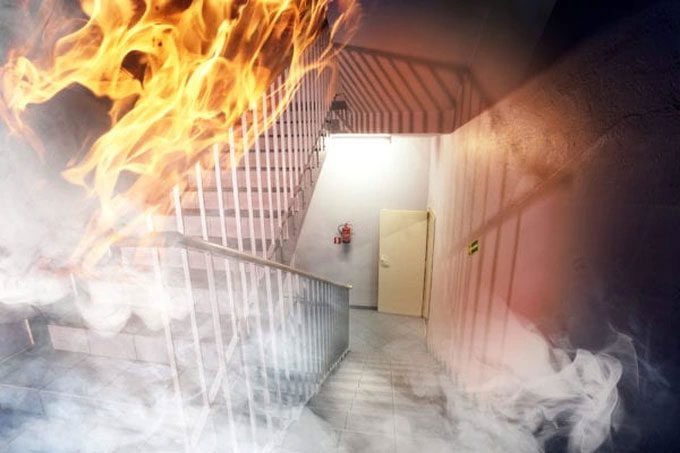The lives of victims in fire accidents are often measured in minutes. In many cases, they must fend for themselves before any rescue units can reach the scene.
Formation of a Fire
A fire is the visible effect of combustion, existing as a special chemical reaction between oxygen in the air and certain substances that act as “fuel.”
The first condition for a fire is that the fuel must be heated to its ignition temperature for combustion to occur. The fuel can be solid, liquid, or gas.
During the chemical reaction that produces fire, the fuel is heated to the point of releasing gases from its surface.

The fire triangle, involving heat, fuel, and oxygen. (Photo: Torklaw).
At this point, the fire is formed and simultaneously releases thermal energy. The combustion process can be slow or fast depending on the amount of available oxygen. However, typically, the combustion process generates flames very quickly and continuously.
The danger of a fire is that it will not stop as long as there is enough heat, fuel, and oxygen. These three elements form a “fire triangle.” Since these three factors are inseparable, removing any one of them can prevent or completely extinguish the fire.
A common method is to use water to douse the fire. In some cases, water acts to absorb heat and extinguish fires caused by wood or paper.
For small fires, we can also easily handle them by covering them with a blanket. This removes oxygen from the combustion process, causing the fire to gradually extinguish.
What Kills Victims?

Burns and asphyxiation are the main causes of death for victims.
In large fires, there are typically two main causes of death for victims: burns and asphyxiation.
The first group of causes comes from injuries due to burns. These burns are not only from direct contact with flames but also occur in the form of respiratory burns when victims inhale hot fumes into their lungs.
The second group, which is much more common, is death due to asphyxiation or poisoning. According to Science Direct, fires consume all the oxygen and fill the space with carbon dioxide (CO2). This causes victims to experience asphyxiation, leading to perceptual disturbances, disorientation, and even unconsciousness.
At the same time, direct exposure to toxic gases can cause the body to collapse and lead to rapid death on-site. The frightening aspect is that this asphyxiation process occurs very quickly, typically within just a few minutes when the body does not have access to sufficient oxygen.
How to Survive a Fire?
The lives of victims in fire accidents are often measured in minutes. In many cases, they must fend for themselves before any rescue units can reach the scene.
Therefore, being aware of the danger and devising countermeasures is seen as a decisive factor between life and death. Even in emergency situations, it is important to stay calm, assess your options, and don’t forget to alert those around you.

The lives of victims in fire accidents are often measured in minutes.
The simplest thing we can do is to use familiar items like towels, pieces of fabric, or even wet clothing to cover our noses. The water molecules and the fabric layer will help reduce the impact of toxic gases on the body while also preventing respiratory burns.
Additionally, victims should try to find sources of “clean” air, which means stooping low (as toxic gases tend to rise), and attempting to run away from the fire or to a safe exit.
Absolutely do not hide in a room, bathroom, or use elevators as the risk of getting trapped is very high.
If the fire situation is not dangerous or widespread, you can try basic firefighting measures, such as using a fire extinguisher, water, or blankets… Additionally, be sure to move flammable items away and close doors along your path to limit the spread of the fire.
If you cannot escape from a fire in a high-rise building, quickly move to open, visible areas such as rooftops or balconies. This will help reduce smoke inhalation and increase your chances of being rescued sooner.


















































